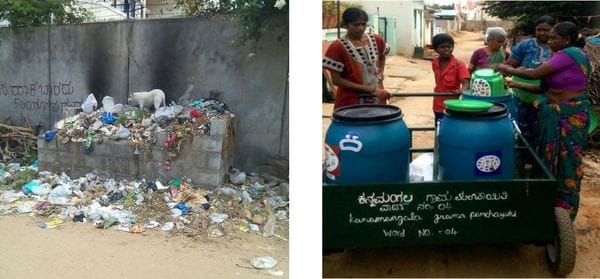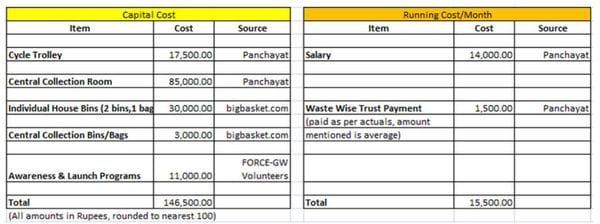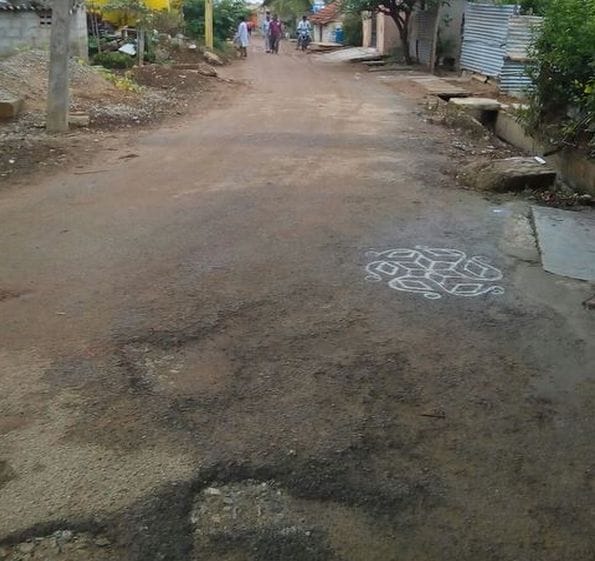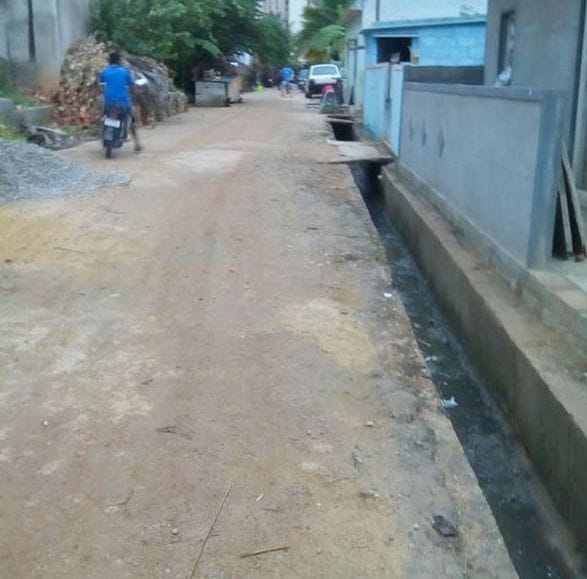Bevinmara Colony – Before and After. Pic: Team FORCE-GW
Bevinmara Colony is a small village in Whitefield surrounded by high-rise apartments and high-end villa communities. The village has about 300 households, 6 shops, 3 temples and 1 church. Residents of Bevinamara Colony needed help in improving the overall condition of the colony in the areas of education, health and infrastructure. Proper Solid Waste Management (SWM) in the village was one of the many initiatives that the Federation of RWAs, Communities and Establishments of Greater Whitefield (FORCE-GW ) wanted to implement in Bevinmara Colony. The residents of the colony were very excited and enthusiastic to adopt this, along with other programs, to make their village a model village.
Previous state of solid waste management
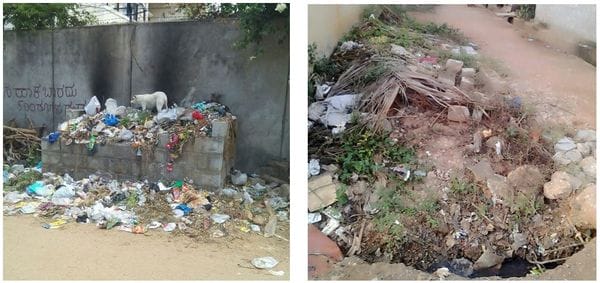
Prior to implementing solid waste management practices. Pic: FORCE-GW
There were three hollow-block collection points built in the colony. The unsegregated waste was dumped by residents directly into these structures. The local panchayat had contracted out the waste collection from the village. These contractors came once in a few days, to empty the dumped waste and took it away in tractors. The frequency of collection was very unpredictable thus leaving the colony, often, in an unhygienic state.
The making of a model village
FORCE-GW had formed taskforces focusing on specific areas like infrastructure, education, environment and health, to lead various initiatives among all member communities. It also had a volunteer team focused on making Bevinamara Colony a model village. This team identified solid waste management as a key improvement area for the village, and engaged the Environment team to implement the same in the village.
Strength in numbers
Using their experience with implementing SWM in their communities, FORCE-GW volunteers chalked out an initial plan. As a next step, the team wanted to customise the same for specific requirements of the village. Fortunately, Bevinamara Colony had an enthusiastic group of youngsters. They eagerly accepted the challenge of making the village a model village, starting with proper waste management practices. With their help, FORCE-GW identified a few key village leaders and volunteers, and a Swachha Bevinamara team was formed.
From awareness to implementation
- As a first step, an awareness program was conducted for all the residents of the village. Nanu-Nagarika helped in conducting an awareness campaign in the local school, where children participated enthusiastically.
- This program gave an opportunity to discuss the plan with the residents. Based on feedback, the team decided to implement segregation at source by implementing the ‘2 bins, 1 bag’ model.
- The plan was reviewed and fine tuned with waste management champions from Kasa Muktha Bellandur and Whitefield Rising.
- Panchayat members at the Kannamangala panchayat office were updated on the plan, and their support was sought to roll out the program in Bevinamara Colony. In addition to their support, the team was also requested to implement the same in all other villages.
- A mini-survey was conducted and where the number of households, number of shops, number of public places (schools, temples, church etc) were identified.
- A discussion was held with residents on central collection points and the need for a covered area to store dry-waste bags.
- Street level volunteers were identified and trained with the knowledge of segregation and best practices.
- Bigbasket.com generously agreed to sponsor the basic needs like segregation kits for all households, a few collection bins etc.
- The Kannamangala panchayat agreed to fund the collection trolley, salary for waste collectors, and construction of storage shed.
- Food waste would be sent to nearby piggeries, and the other waste including dry waste and rejects to Waste Wise Trust.
- A custom-made trolley was designed and fabricated by a Whitefield-based vendor.
- Three people who were willing to work as waste collectors were identified. This was the key piece which fell in place at the right time.
- A small covered space was constructed where the open garbage bin existed before. This is to store dry waste bags and other rejects, which would be periodically picked up by Waste Wise Trust.
- The program was finally launched on August 15th 2015, where Hari Menon of BigBasket.com inaugurated the distribution of the 2 bin, 1 bag kits to residents.
Budget and expenses
Click to view larger image
Summary of best practices in place
- Daily door to door collection of wet and sanitary waste using trolleys
- The segregated waste is collected and stored in big bins and bags
- Collected food waste is picked up by nearby piggery
- Collected dry and reject waste is picked up by Waste Wise Company
- Rent-a-bag concept introduced to the shops in the village (to be implemented soon)
Next steps
- Improved storage place for storing collected waste
- Food waste composting, as a back-up plan
- Find a practical solution for tea shops serving tea in plastic cups
Additional notes
- Kids picked up the basics very quickly and they were the channel to convince elders
- Disposal of Ash: Ash can be used for composting and belongs to wet waste, and cannot be given to pigs. The ash will therefore be collected separately, and used as manure for the greenery around.
